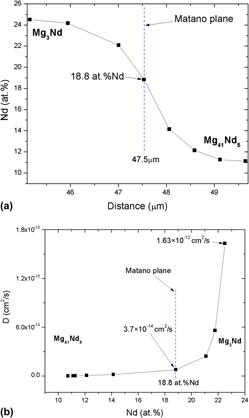Crossref Citations
This article has been cited by the following publications. This list is generated based on data provided by
Crossref.
Mostafa, Ahmad
and
Medraj, Mamoun
2015.
Experimental Investigation of the Mg-Nd-Zn Isothermal Section at 300 °C.
Metals,
Vol. 5,
Issue. 1,
p.
84.
Dai, Jiahong
Jiang, Bin
Zhang, Jianyue
Yang, Qingshan
Jiang, Zhongtao
Dong, Hanwu
and
Pan, Fusheng
2015.
Diffusion Kinetics in Mg-Cu Binary System.
Journal of Phase Equilibria and Diffusion,
Vol. 36,
Issue. 6,
p.
613.
Kammerer, C.C.
Behdad, S.
Zhou, L.
Betancor, F.
Gonzalez, M.
Boesl, B.
and
Sohn, Y.H.
2015.
Diffusion kinetics, mechanical properties, and crystallographic characterization of intermetallic compounds in the Mg–Zn binary system.
Intermetallics,
Vol. 67,
Issue. ,
p.
145.
Paliwal, Manas
Das, Sazol K.
Kim, Junghwan
and
Jung, In-Ho
2015.
Diffusion of Nd in hcp Mg and interdiffusion coefficients in Mg–Nd system.
Scripta Materialia,
Vol. 108,
Issue. ,
p.
11.
Dai, Jiahong
Shen, Shijun
Jiang, Bin
Zhang, Jianyue
Yang, Qingshan
Jiang, Zhongtao
Dong, Hanwu
and
Pan, Fusheng
2016.
Interfacial reaction in (Mg-37.5Al)/(Mg-6.7Nd) diffusion couples.
Metals and Materials International,
Vol. 22,
Issue. 1,
p.
1.
Kammerer, C. C.
Kulkarni, N. S.
Warmack, B.
and
Sohn, Y. H.
2016.
Interdiffusion in Ternary Magnesium Solid Solutions of Aluminum and Zinc.
Journal of Phase Equilibria and Diffusion,
Vol. 37,
Issue. 1,
p.
65.
Jiahong, Dai
Hongmei, Xie
Bin, Jiang
Cheng, Peng
Zhongtao, Jiang
Qingshan, Yang
and
Fusheng, Pan
2018.
Interfacial Reaction Between Mg-40Al and Mg-20Ce Using Liquid-Solid Diffusion Couples.
Rare Metal Materials and Engineering,
Vol. 47,
Issue. 7,
p.
2042.
Kim, Jae Nam
Lee, Chong Soo
and
Jin, Young Sool
2018.
Structure and Stoichiometry of MgxZny in Hot-Dipped Zn–Mg–Al Coating Layer on Interstitial-Free Steel.
Metals and Materials International,
Vol. 24,
Issue. 5,
p.
1090.
Mehta, Abhishek
Dickson, Judith
Newell, Ryan
Keiser, Dennis D.
and
Sohn, Yongho
2019.
Interdiffusion and Reaction Between Al and Zr in the Temperature Range of 425 to 475 °C.
Journal of Phase Equilibria and Diffusion,
Vol. 40,
Issue. 4,
p.
482.
Sabooni, S.
Galinmoghaddam, E.
Turkin, A.A.
Lu, L.Q.
Westerwaal, R.J.
Boelsma, C.
Zoestbergen, E.
and
Pei, Y.T.
2020.
Tailoring vapor-deposited ZnMg–Zn bilayer coating for steels by diffusion-driven phase transformation.
Journal of Alloys and Compounds,
Vol. 836,
Issue. ,
p.
155448.
Mehta, Abhishek
Zhou, Le
Keiser, Dennis D.
and
Sohn, Yongho
2020.
Anomalous growth of Al8Mo3 phase during interdiffusion and reaction between Al and Mo.
Journal of Nuclear Materials,
Vol. 539,
Issue. ,
p.
152337.
Fan, Shihao
Yue, Rui
Li, Song
Yuan, Guangyin
and
Jin, Zhaohui
2021.
First-principles calculations of diffusion activation energies for designing anti-self-aging biodegradable zinc alloys.
Journal of Materials Research,
Vol. 36,
Issue. 7,
p.
1475.
Lu, X.L.
Wang, J.
Huang, Q.Y.
Chen, J.S.
and
Sun, B.Z.
2022.
Precipitation evolution induced by electron beam irradiation in Mg-RE alloys.
Materials Characterization,
Vol. 192,
Issue. ,
p.
112196.
Shi, Hui
Huang, Yuanding
Luo, Qun
Gavras, Sarkis
Willumeit-Römer, Regine
and
Hort, Norbert
2022.
A short review on diffusion coefficients in magnesium alloys and related applications.
Journal of Magnesium and Alloys,
Vol. 10,
Issue. 12,
p.
3289.
Liu, Fali
Fang, Liyang
Li, Zhiying
Tan, Yongkang
Wang, Jiang
He, Xiancong
Xu, Guanglong
Ouyang, Yifang
and
Tao, Xiaoma
2023.
Diffusion behaviors and mechanical properties of binary Mg–Ce system.
Vacuum,
Vol. 216,
Issue. ,
p.
112409.
